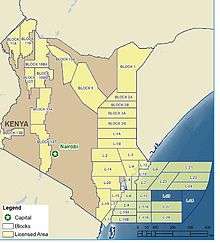Petroleum industry in Kenya
The petroleum industry in Kenya is relatively new in term of mining and exploration. Oil was first discovered in 2012 by a British firm Tullow oil. As to whether they are commercially viable is still being analysed. Currently, the oil industry is controlled by importation and refining.
History

The history of oil marketing in Kenya began in 1903 during colonial times. Initially, kerosene was the main import in tins but later gasoline was imported in tins and drums. Royal Dutch Shell established the first depot on the Mombasa island at Shimanzi.
In 2006, Uganda confirmed the discovery of significant quantities of oil reserves in the Albertine Graben region. By the end of 2013, oil deposits were estimated to be 3.5 billion barrels. In 2014 Uganda has revised oil reserves to 6.5 billion barrels.[1][2]
According to Deloitte in 2013, Kenya has four prospective sedimentary basins: Anza, Lamu, Mandera and the Tertiary Rift.The Lamu basin extends offshore.[3]
Oil is regulated by the Energy Regulation Commission and the Ministry of Mining. Current traders include the National Oil Corporation of Kenya, Shell, Tullow Oil, KenolKobil, MOGAS, Hass, Hashi Energy, Gulf Energy, Olympic, Dalbit Petroleum.
See also
References
- ↑ Kavuma, Richard M. (2009-12-02). "Great expectations in Uganda over oil discovery". The Guardian. ISSN 0261-3077. Retrieved 2017-04-07.
- ↑ "Uganda announces oil discovery | IOL". Retrieved 2017-04-07.
- ↑ http://docplayer.net/20731674-The-deloitte-guide-to-oil-and-gas-in-east-africa-uniquely-structured.html